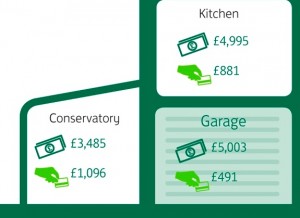Conservatories rank high on British homeowners spending priorities
 The latest Britain at Home report from Lloyds Bank Insurance reveals interesting data about British home life. The bi-annual report is designed to build a comprehensive picture of a British home and owners’ spending priorities, by shining a light on the way we invest in and utilise our homes and gardens. The latest report explores how homeowners live today, compared to how they lived in their childhood. This insight is based on research carried out on 2,000 UK homeowners in August 2014.
The latest Britain at Home report from Lloyds Bank Insurance reveals interesting data about British home life. The bi-annual report is designed to build a comprehensive picture of a British home and owners’ spending priorities, by shining a light on the way we invest in and utilise our homes and gardens. The latest report explores how homeowners live today, compared to how they lived in their childhood. This insight is based on research carried out on 2,000 UK homeowners in August 2014.
The report reveals many interesting facts that are closely associated with the home improvement industry, pointing to key drivers in how homeowners view their own homes. The top reasons why homeowners spend money on their home shed light on the underlying factors that can lead to home improvements. The main reason is to improve how the home looks (65%), while other areas such as to increase its value (23%) and to make more space (12%) also rank highly.
The report looks at how homeowners invest in their homes and by how much. Top of the list is the living room with a value of £5,031 and with an average spend in the last 12 months of £607. Pleasing to the fenestration sector is the quoted relatively high ranking of a conservatory. In terms of money spent in the last 12 months, the conservatory ranks top at £1,096 but for value, it comes in at fifth with a spend of £3,485 behind living room, garage (£5,003), kitchen (£4,995), and study/office (£3,511).
Professor Barrie Gunter, author of Psychology of the Home and contributor to the report said: “A home is not just a building in which we live. It is an extension of the self. It only becomes a home when it reflects who we are as individuals. The choices we make about the kind of home we seek as adults can be significantly influenced by our childhood experiences. As adults, our first property choices are more often determined by what we can afford. Whatever our budget, we will still try to personalise our living space through the choices we make over décor, furnishings, and the way we arrange objects around us. Once the physical space around us resonates with our personality, it takes on the essence of a ‘home’.
“When our economic circumstances allow us to have more choices, we will often seek properties containing features that enable us to recreate our first happy memories of home life. The economic struggles that many face today mean that while they feel some attachment to their own home, it often does not match the feelings they had towards their childhood home.
“This was true of many people in their 30s and 40s in this research. Many told us that their current home was not yet their dream home – one which perhaps matched the emotional attachment they felt to the home in which they were brought up. Older people however showed stronger emotional attachment to their home.
“Modern-day homes have changed to reflect changing lifestyles. More are working from home, so it is not only the place where they live but becoming more integrated with their working lives. Where they live must not only cater to their needs for shelter, security and comfort, but also provide a space that serves as an effective working environment.”
As well as helping homeowners create their dream homes, fenestration products also have another important role. The report places emphasis on ensuring the home is kept safe by stating the need to make sure that windows and doors remain securely locked to help deter thieves.











